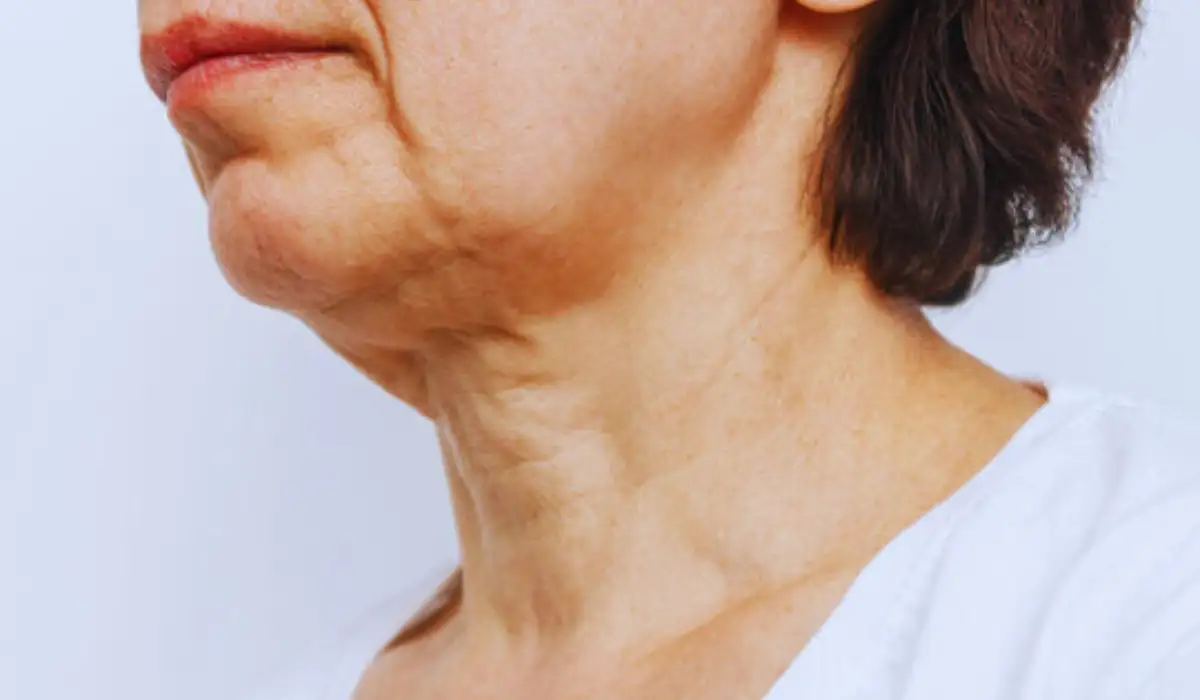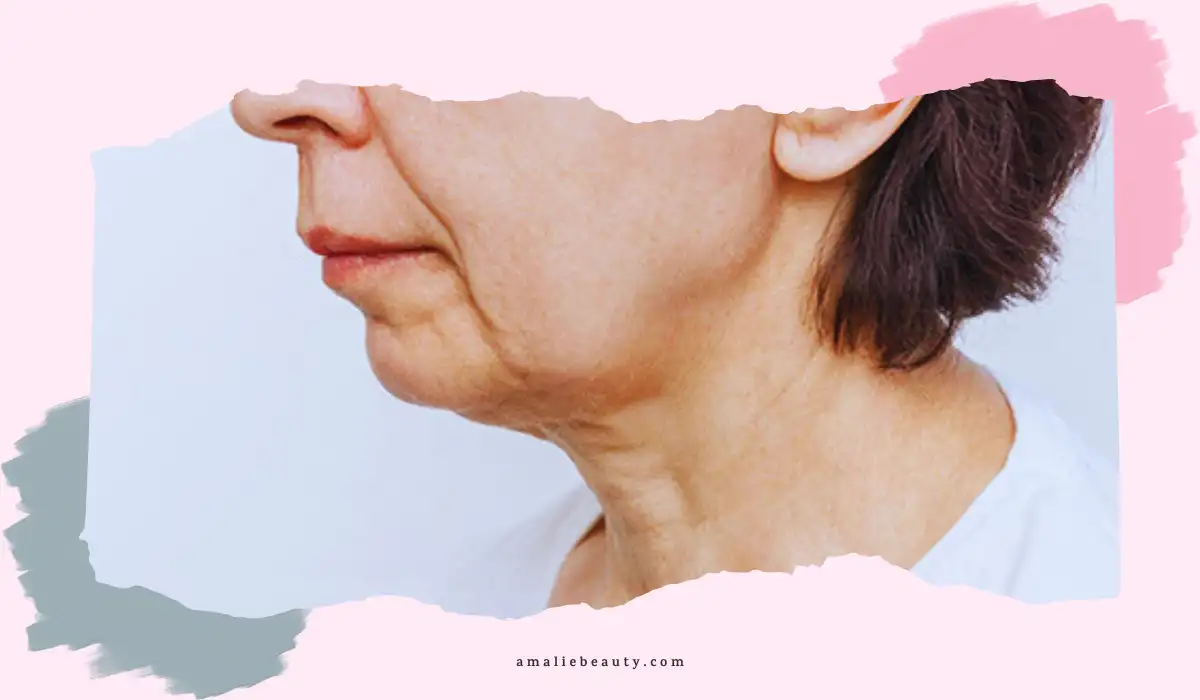Several older people worry about sagging skin, which can be caused by several circumstances. Maintaining healthy, youthful skin requires understanding causes, preventing them, and finding effective remedies.
This article will examine the main causes of drooping skin, preventive measures, and the best therapies.
Causes of Sagging Skin

Aging is a major cause of sagging skin. Skin loses firmness and resilience when collagen and elastin production diminishes with age.
UV radiation from the sun increases collagen breakdown, causing premature aging and sagging. Other factors like heredity, smoking, and bad nutrition contribute to drooping skin.
➡️ Aging and Decreased Collagen Production
Natural aging creates sagging skin. As we age, collagen production decreases, affecting skin structure and flexibility.
Collagen scaffolds the skin, making it firm and resilient. As production decreases, the skin loses its tautness, causing drooping and wrinkles.
➡️ Loss of Elastin
Elastin is another important protein for skin elasticity. Along with collagen, elastin helps skin stretch and return to shape. Elastin production decreases with aging and reduces skin suppleness. In active areas like the face and neck, the cumulative result is sagging skin.
➡️ Sun Exposure and UV Damage
Long-term sun exposure causes accelerated aging and sagging skin. UV rays enter the skin and destroy collagen and elastin.
Damage stimulates the breakdown of these important proteins, causing skin firmness loss and drooping. UV exposure can induce sagging, thus sunscreen and sun-safe behaviors are essential.
➡️ Genetics and Skin Structure
Genetics strongly influence sagging skin susceptibility. Genetics affect skin thickness, collagen quality, and structure.
Families with drooping skin may be inclined to it. While genetics set the foundation, lifestyle and preventive interventions can help manage and minimize genetic effects on skin health.
Hormonal Changes, Especially During Menopause
Skin elasticity can be affected by hormones, especially during menopause. The decrease in estrogen during menopause reduces collagen formation, reducing skin thickness and stiffness.
Menopausal women may have drooping skin, especially on the face and neck. Understanding hormonal fluctuations is essential for personalizing skincare to different life phases.
Weight Loss and Fluctuations
Rapid weight loss or fluctuations might cause drooping skin. Weight increase strains the skin, reducing its suppleness.
After weight reduction, the skin may not recover, causing drooping in places like the belly and arms. Maintaining a healthy weight and doing muscle-tone workouts can reduce weight-related drooping.
Drooping skin is caused by aging, environmental exposures, genetics, lifestyle, hormone changes, and weight swings.
For focused prevention and informed treatment, sagging skin sufferers must identify these seven variables. People can prevent drooping skin by understanding its causes.
Prevention Strategies
Sagging skin is unavoidable, but prevention can slow it. Regular UV protection with sunscreen prevents collagen breakdown.
Keeping hydrated, eating a balanced, antioxidant-rich diet, and not smoking helps improve skin health. Hyaluronic, retinoid, and peptide treatments can promote collagen production and skin suppleness.
➡️Sun Protection and UV Safety
Preventing sagging skin requires protecting it from UV radiation. Extended sun exposure increases collagen breakdown, causing premature aging and sagging.
If you spend a lot of time outside, use a broad-spectrum sunscreen with at least SPF 30 and reapply it every two hours. To reduce sun exposure, seek cover during peak sunshine hours, wear protective clothes, and wear wide-brimmed hats.
➡️ Healthy Lifestyle Choices
Healthy living can improve skin health and prevent sagging. Smoking reduces blood flow to the skin and degrades collagen and elastin, speeding up aging.
A healthy diet with fruits, vegetables, whole grains, and lean proteins gives vitamins and antioxidants to the skin. Hydration is essential for skin elasticity and hydration.
➡️ Topical Skincare Products
Use the right skincare products daily to avoid sagging. Retinoids from vitamin A increase collagen production and skin cell turnover, reducing wrinkles and sagging.
The amino acids in peptides help build collagen and firm skin. Skin becomes suppler with hyaluronic acid. A dermatologist can modify your skincare routine.
➡️ Regular Exercise and Muscle Toning
Exercise prevents drooping skin and enhances health. Regular exercise improves blood circulation and collagen production.
Strength training supports the skin by toning muscle. Exercise the face, neck, arms, and abdomen to reduce sagging. Balanced exercise promotes skin and health.
➡️ Maintaining a Stable Weight
Sagging skin might result from rapid weight loss or weight changes, especially in stressed regions. Maintain a healthy weight with nutrition and exercise.
Skin elasticity loss with crash diets and severe weight loss worsens sagging. Slow, steady weight loss maintains skin firmness and prevents drooping.
➡️ Adequate Hydration
Skin elasticity and sagging prevention depend on proper hydration. Since the skin needs moisture to stay supple, dehydrated skin ages faster.
Drink plenty of water and use moisturizers with hyaluronic acid. Hydrated skin resists gravity, keeping it plump and youthful.
➡️ Limiting Alcohol Consumption
Extreme alcohol use might cause skin elasticity loss. Alcohol dehydrates and deprives the skin of nutrition, making it sag.
Staying hydrated and limiting alcohol intake can promote skin health and prevent premature aging. Drink moderately and drink lots of water.
➡️ Topical Treatments
Many topicals can help sagging skin. Retinoids from vitamin A reduce wrinkles and sagging by increasing collagen production and cell turnover.
Peptides, amino acids, assist collagen synthesis. Hydrating and elasticizing hyaluronic acid moisturizers and serums exist.
➡️ Non-Invasive Skin Tightening Procedures
Because they rejuvenate drooping skin without surgery, non-surgical skin tightening treatments are popular.
Radiofrequency and ultrasound increase collagen and skin elasticity. Radiofrequency heats deeper skin layers to rebuild collagen.
Targeted ultrasound tightens layers organically. These procedures work for mild to severe sagging without surgery-related downtime.
➡️ Dermal Fillers and Injectable
Dermal fillers and injectables instantly improve drooping skin, changing cosmetic dermatology. Restylane and Juvederm can be carefully injected to lift drooping skin.
This treatment targets nasolabial folds, marionette lines, and cheek volume. Botox reduces wrinkles and sagging by relaxing muscles. Non-surgical therapies have temporary effects that may require maintenance.
➡️ Surgical Facelift
Surgical facelifts are excellent for advanced sagging and long-lasting results. To look younger, a facelift, or rhytidectomy, removes excess skin and tightens underlying tissues.
Drooping mid-face, jawline, and neck are corrected with astonishing and long-lasting results. A facelift fixes serious sagging and aging concerns, but it takes longer to heal than non-invasive therapies.
Conclusion
Sagging skin is a natural feature of aging, influenced by genetics, sun exposure, and lifestyle. Sagging may be unavoidable, but a holistic strategy that involves skincare, lifestyle changes, and expert treatments can enhance skin elasticity and delay its development.
Knowing the causes and taking preventative measures early can help people age gracefully and have healthy, glowing skin.
References
- Humbert P, et al. (2015). Mécano-Stimulation™ of the skin improves sagging score and induces beneficial functional modification of the fibroblasts: Clinical, biological, and histological evaluations.
https://www.ncbi.nlm.nih.gov/pmc/articles/PMC4321566/ - Asserin J, et al. (2015). The effect of oral collagen peptide supplementation on skin moisture and the dermal collagen network: evidence from an ex vivo model and randomized, placebo-controlled clinical trials. DOI:
https://doi.org/10.1111/jocd.12174

